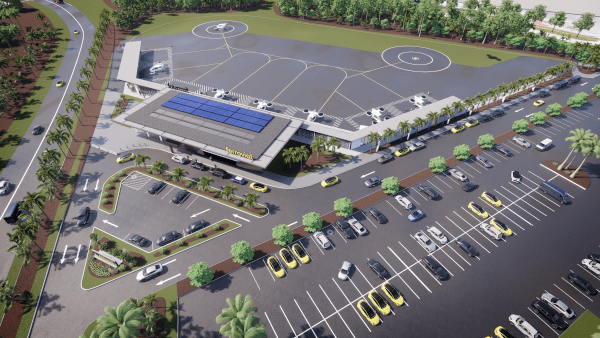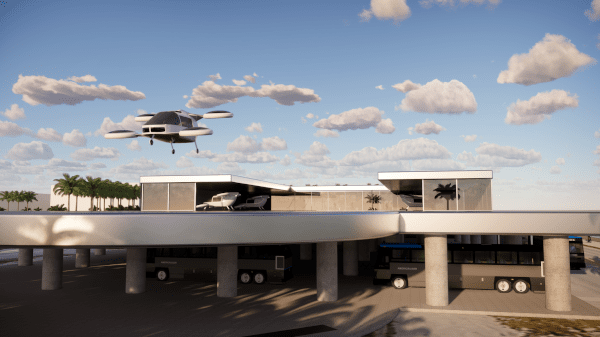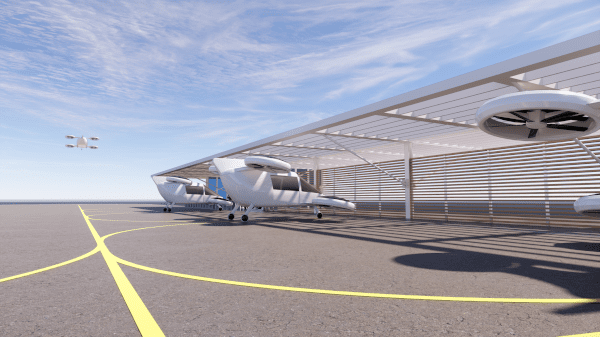
Humans have long been enamored with flight. From the 1783 ascent in a Montgolfier balloon to the Wright brothers’ 1903 powered flight, people have yearned for the freedom of the skies.
So what would those pioneers of flight think of the next revolution in powered air transport? What would they give to be able to leapfrog urban congestion or hop from a city center to a nearby airport or town in minutes, and to be able to do it in a zero-emission electric aircraft that takes off and lands vertically?
Urban air mobility readies for take-off
Today, there are dozens of eVTOLs (electric vertical take-off and landing aircraft) in various stages of development. Their makers are aiming at the nascent, but potentially highly profitable urban air mobility (UAM) market. This sustainable transportation mode is much more than a flying taxi service: it will transform the way we move—for work and fun—within and between cities around the world.
eVTOLs will simplify and speed up urban and regional mobility by providing fast, safe, reliable, and convenient connections within and between cities. Today, over half of the world’s population (4.4 Billion people) live in cities. This trend is expected to continue, with the urban population projected to more than double its current size by 2050, at which point nearly 7 of 10 people will live in cities. This flight to urban environments has led to congestion, and will continue to push transportation infrastructure to its limit. Fortunately, eVTOL’s offer a three-dimensional solution to an ever-growing transportation problem. In doing so, eVTOL’s are expected to substantially shorten journey times—often by more than half—and reduce CO2 emissions by displacing fossil-fuel-based transport modes.
However, to get UAM off the ground, eVTOLs must prove that they are safe and reliable, be affordable, and, critically, have a well-planned network of places to take-off and land.

And that’s where vertiports come in. The infrastructure for landing, recharging, taking off, and speedily processing fare-paying passengers needs to be in place and in the right places. Success depends the ability of vertiports to simplify travel by avoiding the long lines and wait times of traditional airports. Location is critical too; they need to be spread widely throughout the urban environment and integrated into existing transport hubs.
Our vision for vertiport networks starts with seamless integration into urban landscapes. Our vertiports will be intermodal centers adapted to fit the local urban environment. They will serve all eVTOL aircraft and service models, reduce noise, and improve energy efficiency through innovative design. They will target zero-carbon emissions using natural elements, including sunlight and renewable energy.
While our focus is on developing vertiports that are convenient for passengers, eVTOLs could in future provide medical or emergency response as well as cargo services, all of which would create new jobs in the communities served.
What will vertiports look like?
Designs for the airside elements of a Ferrovial vertiport will mostly be driven by regulatory and safety factors, just as they are at an airport. These factors include distances between eVTOLs, distance of the landing area from the gate, ability to safely recharge, and the airspace they can fly in. We expect our vertiports to have two to eight stands, depending on demand, and to be agnostic in terms of eVTOL manufacturer and their respective business plans. Multiple design types with various business models are likely to serve various market needs including intra-city, inter-city, and connections to airports.
Vertiports should not come as a one-size-fits-all design. They need to be flexible and adaptable for specific sites or uses, including dense urban environments. That’s one of their advantages. Another is that eVTOLs need much less space to take off and land. So vertiports operate on a much smaller footprint than land-hungry airports. In fact they could easily be small enough to be raised off the ground and built with parking beneath.
In choosing sites, we consider a broad range of safety, operational, demand, and community factors, and we design our vertiports in a way that allows for cost-effective expansion. While facilities may vary, each vertiport needs to be where people live, work, and play, and to have easy last-mile connections. And they must be good neighbors, minimizing noise and operating sustainably.

Our vision for vertiports includes integration with other forms of transport, including hub and regional airports. Airlines are interested in how eVTOLs could boost passenger feed and provide additional connectivity, while some eVTOL operators plan to offer intra- or inter-urban services.
Each location naturally depends on a business case driven by local market demand and government or regulatory requirements. To that end, we are in discussions with a range of global airlines and eVTOL operators about how our vertiports and eVTOL services could support their plans.
How soon will this all happen?
To borrow a phrase from my former airline career, I would say it is nearly ready for take-off. We’ve been studying this emerging sector for the past four to five years and have confidence in our business case and demand projections. We’re also confident about the trajectory of eVTOL technology, which is being certified by regulators and should be commercially available within two years. Numerous manufacturers, ranging from well-funded new entrants to established and well-known OEMs, have aircraft types currently undergoing regulatory certification for commercial use – possibly as soon as 18 to 24 months from now.
As the aircraft come online, we will be designing and building the infrastructure. We envision building vertiport networks across the United States and Europe, and have initiated site analysis and begun negotiating and securing sites.
As with all our infrastructure projects, we’re committed to working collaboratively with government and regulatory officials and with communities to develop vertiports to the highest standards.
Supported by our company’s ability to finance, construct, and manage large, complex projects, we are in a strong position to play a key industry role in developing vertiport networks. Our team brings tremendous experience in aviation, airlines, and airports to this nascent industry, backed by Ferrovial’s financial strength and experience. All of which make us a great partner for a breakthrough industry that will transform urban mobility for decades to come.





There are no comments yet